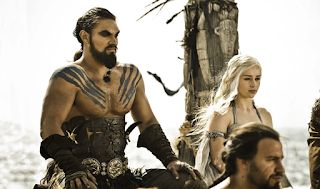Sexism in ASOIF
In Saladin Ahmed’s article on
Salon.com “Is Game of Thrones too White?” he examines racial representation in
ASOIF in order to get at the bigger question: is today’s fantasy literature too
white? While Ahmed agrees fantasy literature is in a better place today than it
was in Tolkien’s time, he believes it still isn’t in the best place. This is
primarily because although fantasy literature is more racially inclusive today,
people of color are not always represented in the best light. While these are
important questions, I think it is equally important to ask: is fantasy literature
less sexist today than it was in Tolkien’s time? This question, like Ahmed’s
has a complicated answer.
It
is undeniable that ASOIF does show improvement over fantasy literature
during Tolkien’s time. The presence of characters like Ayra Stark and Brienne
of Tarth reflects a more open-minded approach to character development than
normally expected in medievalism. Although it is a common misconception that
warrior women didn’t live during medieval times, it does not stop a large
majority of people from believing it to be inaccurate for characters such as
Ayra and Brienne to be present in ASOIF and similar works. Many would say they
are simply present in the franchise to satisfy feminist readers/viewers, but as
we have discussed in class this simply is not the case.
Ayra and Brienne
are not the only examples of strong women in ASOIF, however. Women certainly
don’t have to be well trained with a sword to be powerful in Martin’s word.
While there is no shortage of examples of empowered women of nobility (Cersei,
Daenerys, older Sansa, Lyanna Mormont, Olenna Tyrell, etc.), there are even a
few examples of hard working businesswomen. For example Chataya, a prostitute
from the summer isles, owns an upscale brothel in King’s Landing. While owning
a whorehouse definitely isn’t the best business Martin could have placed his
female entrepreneur in, at least Chataya exists and a man doesn’t own the
whorehouse.
However,
at the same time, I wouldn’t go so far as to say Martin is the most enlightened
person when it comes to women. Nearly every female in ASOIF is sexualized at
some point including young girls like fourteen-year-old Daenerys. Additionally,
HBO has taken great liberty in showing frequent nudity. This begs the question:
how female positive can ASOIF be when it is drowning in boobs? I, like Ahmed,
basically believe that fantasy literature has made improvements when it comes
to being inclusive. At least here women are main characters and serve more than
to act as damsels in distress. In Martin’s world they can be knights, faceless
men, sole rulers of kingdoms, or even just own their own business, and at least
that’s more than women got in Arda. Of course Martin is sex obsessed and we
have to read a description of every woman in ASOIF’s breasts but at the end of
the day Martin has written an outstanding story. Unfortunately that story was
written during a time that was/is still sexist, racist, and xenophobic and will
inevitably reflect that.



The answer to your initial question, as you've reviewed, is indeed very complicated. While fantasy is in a better place than it once was, are we going to be content with where it is, or continue striving to improve upon its representation further? While the morality and perspective of novels are usually influenced by the real world they originate from, do authors have to wait for the world to change for their representation of women and PoC to change? Or can we use novels to reflect how the world could more positively portray women and PoC?
ReplyDelete